Physical Address
304 North Cardinal St.
Dorchester Center, MA 02124
The ilioinguinal approach allows access to visualize the entire anterior column of the acetabulum, as well as palpable access to portions of the posterior column.
The Stoppa approach can be used for exposure of the anterior pelvic ring and in conjunction with the lateral window of the ilioinguinal approach for exposure of the acetabular region.
The Kocher-Langenbeck approach allows direct visualization of the dorsocranial part of the acetabulum through the fracture gap or after capsulotomy.
The extended iliofemoral approach is used in the treatment of certain T-type or transtectal transverse acetabular fractures with acetabular dome impaction or associated fractures of the posterior wall, and may also be useful for the treatment of malunited fractures or fractures that are several weeks or months old.
The ilioinguinal approach allows access to visualize the entire anterior column of the acetabulum , as well as palpable access to portions of the posterior column. Multiple neurovascular structures must be identified, mobilized, and carefully protected during this exposure. Modifications to this exposure allow full access to the quadrilateral surface of the acetabulum as well. This exposure involves opening portions of the abdominal wall, and careful closures are required to prevent the formation of hernias.
Anterior column fractures of the acetabulum.
Both-column fractures of the acetabulum.
In conjunction with other approaches or for use alone:
Transverse fractures of the acetabulum.
Anterior column-posterior hemitransverse fractures of the acetabulum.
T-type fractures of the acetabulum.
Anterior wall fractures of the acetabulum.
The ilioinguinal approach is performed with the patient in the supine position ( Fig. 13.1 ). The arms of the patient may be tucked at the side, but placing them in an abducted position may facilitate exposure of the lateral window and may improve the ability to obtain intraoperative oblique radiographs of the operative region. A radiolucent fracture table with a perineal post and leg traction can be used with this approach to assist in obtaining reduction of the fracture. A urethral catheter should be placed in the patient's bladder before the surgical site is prepared to decompress the bladder.
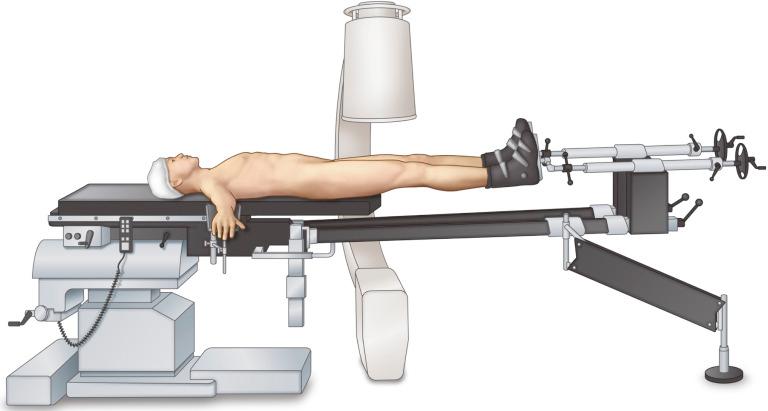
The iliac crest is palpated from the anterior superior iliac spine posteriorly. Additionally, the pubic symphysis is palpated and the midline of the abdomen is located. The operative field is prepared from an area proximal to the superolateral portion of the iliac crest to the superior portion of the introitus or the top of the penis. The umbilicus can be carefully draped out of the field. Care should be taken to note scars from previous herniorrhaphies or surgeries in the inguinal region and prior Pfannenstiel incisions from gynecologic/urologic surgery; previous cesarean section scars should be noted and can be incorporated into the surgical incision.
The skin over the lateral aspect of the iliac crest is incised from the anterior superior iliac spine posteriorly 10 to 15 cm depending on the size of the patient ( Fig. 13.2 ). Dissection is carried through the skin subcutaneous tissue with hemostasis gained along the way. The fascia over the hip abductors and the fascia over the abdominal musculature are identified. These fasciae come together into an aponeurosis over the proximal lateral aspect of the iliac crest. This aponeurosis is incised in line with its fibers along the iliac crest ( Fig. 13.3 ).
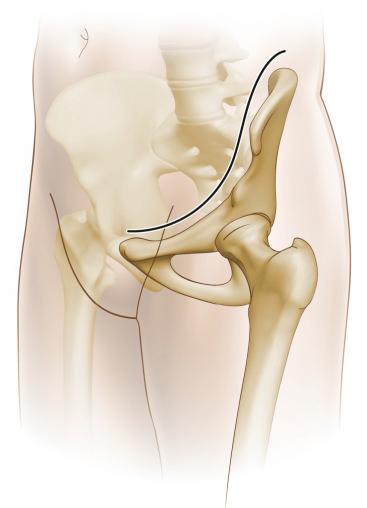
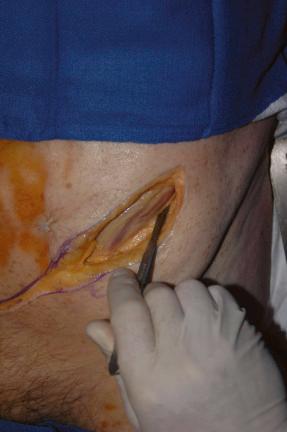
Subperiosteal dissection along the superolateral aspect of the iliac crest elevates the abdominal aponeurosis into the inner table of the ilium.
A large periosteal elevator is used to elevate the iliacus muscle from its origin on the inner table of the ilium. Nutrient vessels encountered at this time can contribute to a significant hemorrhage in this region. Care should be taken to identify these vessels and coagulate when possible. In certain instances, coagulation may not be possible, and the use of bone wax in this region may help with hemorrhage control.
Once the iliac fossa has been exposed, a sponge is placed into this wound to pack it off while further dissection is performed distally.
The skin incision is extended from the anterior superior iliac spine to a point approximately 2 cm proximal to the pubic symphysis. The skin incision needs to be extended beyond the midline by 3 to 5 cm to gain full exposure of the rectus abdominis.
Once the incision is carried to the level of the abdominal fascia, the fascia of the external abdominal oblique is identified as it courses toward the external inguinal ring. The inguinal ligament is identified coursing from the anterior superior iliac spine to the pubic tubercle. The spermatic cord or round ligament should be identified exiting from the superficial inguinal ring. A Penrose drain or surgical tape can be placed around this structure for control and mobilization ( Fig. 13.4 ). The external abdominal oblique is dissected in line with its fibers and is incised 3 to 5 mm proximal to the inguinal ligament, leaving tendon on each side for later repair ( Fig. 13.5 ). The external abdominal oblique can be split to a point just distal to the superficial inguinal ring, allowing this ring to be maintained in place to decrease the potential for the development of postoperative inguinal hernias.
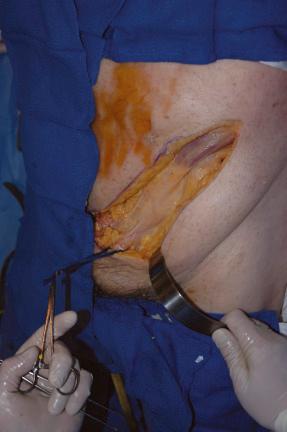
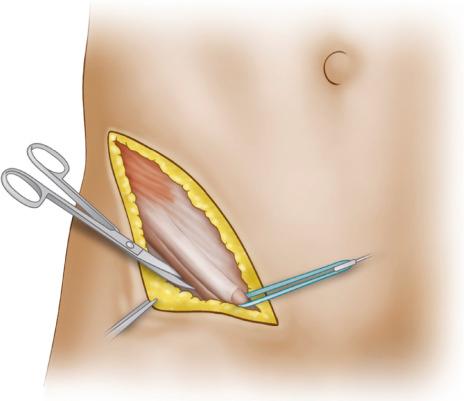
The conjoined tendon of the transversus abdominis and the internal abdominal oblique is identified. Before this muscle is split, care should be taken to identify the lateral femoral cutaneous nerve of the thigh. This nerve courses over the iliopsoas muscle and exits laterally near the anterior superior iliac spine. This nerve may not be able to be preserved in all cases, and careful preoperative discussion with the patient should include the potential for postoperative lack of sensation in the distribution of the lateral femoral cutaneous nerve. Once the lateral femoral cutaneous nerve has been identified, the conjoined tendon of the transversus abdominis and the internal abdominal oblique is incised in line with its fibers ( Fig. 13.6 ). This incision should be made 2 to 4 mm proximal to its insertion on the inguinal ligament. This step will allow later repair of this fascia in 2 separate layers to decrease the chance of postoperative hernia.
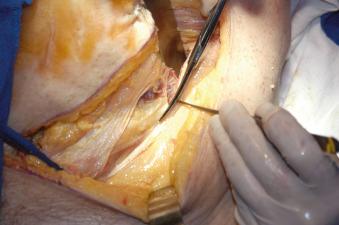
Circumferential control of the iliopsoas with the femoral nerve should be obtained ( Fig. 13.7 ). Care should be taken to ensure that the nerve and the psoas stay together as a single unit. A large, curved clamp can be advanced behind and around the psoas and used to guide a Penrose drain or surgical tape around the neuromuscular unit of the psoas and femoral nerve for retraction and control.
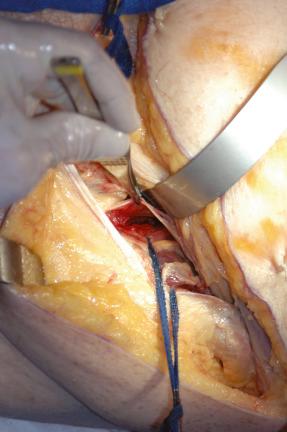
Careful dissection along the iliopectineal fascia is necessary to mobilize the external iliac vessels. These vessels can be identified by palpation of the pulse, and careful dissection mobilizes the vessels medially. With constant protection of the external iliac vessels, the iliopectineal fascia can be split down to the pelvic brim ( Fig. 13.8 ).
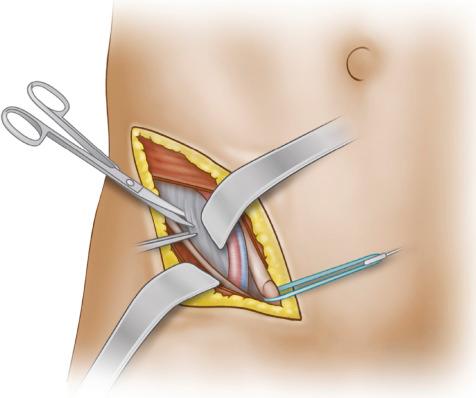
The fascia of the rectus abdominis is identified as it inserts onto the pubic tubercle ( Fig. 13.9 ). This can be incised in a transverse direction to gain access in the space of Retzius. The rectus abdominis should be transected so that the fascial incision is in continuity with the release of the external iliac oblique, as well as the conjoined tendon of the transversus abdominis and the internal abdominal oblique.
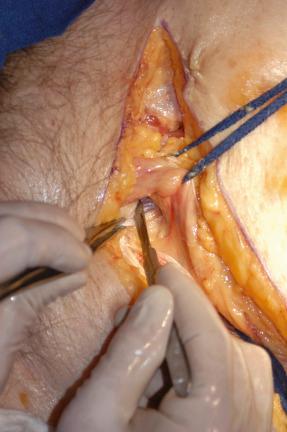
Once the iliopectineal fascia and the rectus abdominis are released, circumferential control of the external iliac vessels can be obtained, and a large, curved clamp can be advanced behind the vessels and used to guide a Penrose drain or surgical tape to maintain control of the vessels ( Fig. 13.10 ). At this point, the three windows of the ilioinguinal approach have been exposed, and the desired surgical procedure can be performed.
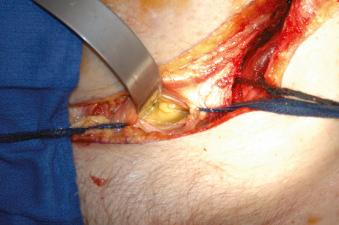
After internal fixation, closure is performed in multiple layers. The transected rectus abdominis fascia is reapproximated using no. 0 nonabsorbable suture.
The conjoined tendon of the transversus abdominis and the internal oblique is closed with multiple nonabsorbable sutures with less than 1 cm spacing between sutures. Additionally, an absorbable suture can be used to overrun this repair to further reinforce the inguinal region.
The external abdominal oblique is then repaired using no. 0 nonabsorbable suture. Drains can be placed deep into the wound, including one drain in the iliac fossa. The aponeurosis of the abdominal musculature is then reapproximated to the aponeurosis of the abductor musculature over the iliac crest. Subcutaneous tissue can be closed in layers using absorbable suture, and the skin can be closed with sutures or staples.
Malleable retractors can be used to retract the iliacus and psoas medially in the lateral window, and then can be moved to the middle window to retract the external iliac vessels medially. The edges of these retractors can be acute, and torque must be maintained on the retractor while in the middle window to prevent it from rotating and the edge from injuring or occluding the vessels.
A pointed lever-type retractor like a Homan can be used in the lateral window to retract the iliacus near the sacroiliac joint. The point of the retractor can be introduced gently into the sacroiliac joint so the entire iliac wing is visualized.
The Stoppa approach can be used for exposure of the anterior pelvic ring and in conjunction with the lateral window of the ilioinguinal approach for exposure of the acetabular region. This exposure uses an extraperitoneal approach with retraction of the bladder, bowel, and external iliac vessels. The Stoppa approach gives access to the quadrilateral surface of the acetabulum and to the low anterior column, the superior pubic ramus, and the pubic symphysis.
The patient is positioned supine on the operating table. The arms can be tucked at the side, although an abducted position may make intraoperative oblique imaging easier, because the arms will not obscure the images. A urethral catheter should be placed in the patient's bladder before the surgical site is prepared to decompress the bladder.
Become a Clinical Tree membership for Full access and enjoy Unlimited articles
If you are a member. Log in here